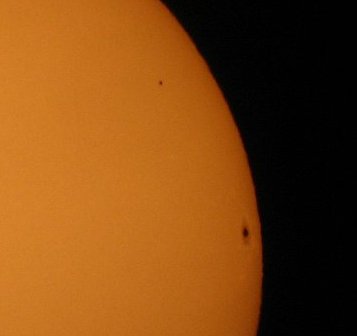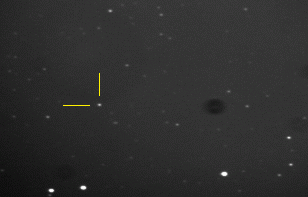Wednesday, December 27, 2006
802.11 wireless networking: channel survey
The survey itself was a bus ride from Midway Airport to Hyde Park via 55th street. The laptop running Netstumbler was closed and sitting in a backpack, with no attempt to improve the signal in any way. 367 networks were detected. It is clear that significant amounts of networks were not found because of the location of the antennas--a previous survey of a few blocks in a well-to-do neighborhood near the University of Chicago (Hyde Park) showed over a hundred networks with a five block walk and a sensitive USB wireless adapter.
22% of the networks did not have encryption turned on. This is not really a bad thing--you shouldn't rely on a completely broken encryption (WEP) to protect your communications. Instead, run a SSH tunnel or a VPN to ensure all communications are secure.
I suppose at this point, from the results of this look, if someone asked me for help about their wireless problems, I'd immediately tell them to switch channels on their access point. A smarter (and probably paid) consultant would scan their location and pick the least populated channel, whatever it was (and odds are it wouldn't be channel 6). That, or switch to the much less popular 802.11a, which runs at 5.8GHz.
Thursday, December 21, 2006
Winter Solstice
Wednesday, December 20, 2006
Carl Sagan
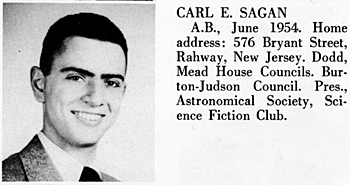
Carl Sagan died ten years ago today. Has it really been ten years? I guess I can say it has: new visitors to Ryerson Observatory often do not know who he was and miss some of the symbology of the one-hundred-and-six-year-old refractor they are peering through. What they don't realize is how important he was not to the advancement of science, but to public science education.
He was a student here at Chicago; he was, as the picture indicates, president of the University of Chicago Astronomical Society (now known as the Ryerson Astronomical Society). After his short stay in the college he went to the Astronomy department and left a Ph.D. I quote a visit from John Musgrave, a member of the Society, to Yerkes during Sagan's period there:
I remember the one Yerkes night we had that fall (1958): it was cloudy;
but if it had been clear we could have used any of the telescopes as no
one was using them for research - no one on staff greeted us - just some
"lowly grad students". Rather than observe we heard a lively spur of
the moment lecture by a post-doc introduced to us in somewhat apologetic
tones - "we don't know if he is for real or not" - unusual even by U of
C standards. It was Carl Sagan and he spoke about the possibility of
extraterrestrial life (maybe other things as well - but with Carl I
remember the performance more than the content - including waving
arms). I guess the "we aren't really sure about this guy" label haunted
him through to the end.
I often wonder what the dismal atmosphere of a coal-smoked Chicago was like for astronomy in the early fifties--and whether the old cranky telescope (fifty-two years old then, in 1952) did anything to inspire future thoughts. His logs are short, and there never seemed to be much observing or possibility of observing. See here for a scan of a sample logbook page. Or here for the entire text of the 1952-1964 logbook.

A member of the club in the seventies, when Sagan was back on campus showing off images of the new Viking landers on Mars, got him to sign the logbook yet again. I never met him, but a fellow RAS member at the time, Chris Conselice, was in attendance when they created a graduate student award in the astronomy and astrophysics department. He said he looked quite frail--this would have been 1995 or 96.
Keay Davidson in his biography, "Carl Sagan: A Life", writes:
And atop Ryerson Hall, he and a band of future astonomers learned (with the guidance of the astronomy club advisor, Guy C. Omer Jr.), how to operate equipment in the campus observatory. Other club members included Tobias Owen, who, like Sagan, would go on to a distinguished astronomical career. Sagan ran the astronomy club's "theoretical" section, and arranged speeches by famous professors such as Subrahmanyan Chandrasekhar.
Omer "taught me how to make the right ascension and declination drives go, and gave me a key to the observatory... and so there I was: I could go and look at the stars if ever there was a clear night in Chicago," Sagan later recalled. Yet he wasn't much of a stargazer. The club's logbooks show that Owen and several other members showed up night after night, for years, to meticulously record their observations. But Sagan observed only seven nights between October 1952 and November 1953; and when he observed, he left only terse notes. One searches the logbooks in vain for early fragments of Saganish eloquence. His most vivid entry dates from 2:15 to 3 AM on November 25, 1952, during his sophomore year: "Some [cloud] openings; then clouded over. Also COLD."
...
"Much more important" than stargazing, he later joked, was that at Ryerson Observatory, "I could bring young women to a place where could be undisturbed--which was far and away more important than being able to look through the six-inch telescope!"
In that spirit I leave you with this cartoon from the 1957 Cap and Gown. (My notes have it mislabeled as 1953--it could be 53 or 57, it matters not):
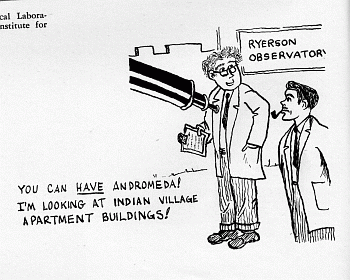
Tuesday, December 19, 2006
Radio Havana Cuba on December 18th
Radio Havana Cuba, 2006-12-18. (30:00, 28MB, 128kb/s mp3). Includes news and music.
Wednesday, December 13, 2006
Geminids tonight
Friday, December 08, 2006
Radioactive dust on air filters

The location where I have my on-line geiger counter is certainly not dust-free: I work in a library after all, and the dust sure looks like paper dust. But the air from outside is well filtered. Since a very easy way to detect radon and its daughter products in the air is to move a large quanity of air through a filter and quickly measure the activity of the picked-up dust, I've tried this out in a variety of places. The result is no radon in my basement office (A-level), no radon in the sub-basement (B-level), but a touch of it in the server room (which has a wall directly against the subsoil).
Yesterday I got lucky: I noticed a trash bin filled with the air filters for the building and took a sample. Sure enough, the readings were elevated. Yesterday it read 11.5 uR/hr with a small piece of the filter against the counter. Today, the same sample read 8.5. (The long-term background average is 7.6).
What's not clear is what radionuclide is the source. I don't know how long the filters were sitting around before I found them. With a radon filter test, it's very important to test as quickly as possible, as you are sampling the short decays of the first four daughters formed from radon-222's decay into polonium 218. That polonium-218 has a 3.05 minute half-life, its daughter lead-214 26.9 minutes, its daughter bismuth-214 19.7 minutes, and the last polonium-214's is only 0.00015 seconds; there's not much time to get a nice graph out of it.
Since the next decay, from lead-210 into bismuth 210 has a half-life of 22 years, I'll never see it unless I had a lot of it lying around. Some researchers use Pb-210 that gets embedded in glass as a long-term measurement for radon levels in old houses.
A topical point is bismuth-210 decays into polonium-210, the poison of Alexander Litvineko which ends the uranium-238 decay chain after decaying into lead-206 (Pb-206)
The whole decay chain for U-238:

Wednesday, December 06, 2006
Recent Water on Mars
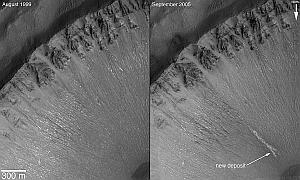
Previous post cut short--because in about linking to Phil Plait's entry about HiRISE images, I just found his link to the press release about water on Mars! Mars Global Surveyor--the one that just died recently-- took images in a southern crater that show a distinct change over the past seven years. A sudden new deposit in a gully on the crater wall.
http://www.msss.com/mars_images/moc/2006/12/06/gullies/centauri_crater/index.html
Image source: NASA/JPL/MSSS
the post-Thanksgiving update
But anyways, I see that HiRISE imaging is going smashingly--they have picked up Spirit and Viking 1:
Monday, November 20, 2006
A better color panorama of Victoria Crater on Mars
Saturday, November 18, 2006
Leonids vs. Geminids
The neat thing about the Geminids is they appear to come from an asteroid-- (3200) Phaeton, rather than a known comet. The simple implication is that Phaeton is just a dead comet, a dehydrated pebble pile.
Friday, November 10, 2006
fyi image outage for tonight
The curious case of a new variable in Cassiopeia: a microlensing event?
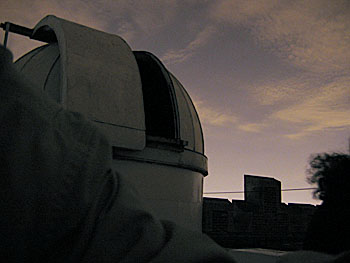
Akihiko Tago of Japan discovered a new bright star in the constellation Cassiopeia on October 31st. Checking back on his images he found the star brightening over the course of a week. New variable stars are discovered rather frequently; novae occur in the Milky Way every year and a few reach naked eye brillance; most are distant and only brighten to 8 or 9th magnitude (which requires binoculars or a telescope to see). In fact Tago is a nova hunter; he photographs the Milky Way constantly in search of new stars. But this new object wasn't a nova.
The new variable in Cassiopeia was identified as being in the same position as a magnitude 11 star--an unremarkable A-type star at 1,000 parsecs, a lot like Vega, which is hotter than the Sun with a surface temperature of about 10,000K. The problem is normal A-type stars are not known for their variability--there are few mechanisms to allow stars of that type to change in brightness, especially by 4 magnitudes. To do so, a star would have to expand 6-7 times in diameter without changing temperature or increase its surface temperature by 2.5x (which would completely change its stellar classification).
A spectra of the star would help identify what had changed about the star to make it brighten. Robin Leadbeater took one, but at first thought he was getting mixed light from a background star, since it didn't have a prominent hydrogen-alpha line like new nova do. Later spectra though proved he was getting the star itself and the background star wasn't causing a problem. There was simply nothing odd about the star that anyone could see.
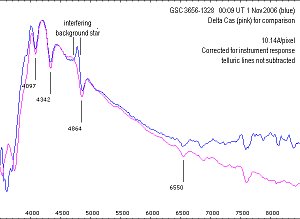
M. Mikolajewski, T. Tomov, A. Niedzielski, K. Czart, and C. Galan from Nicolaus Copernicus University then suggested it might actually be a microlensing event--an object passing between us and the star that bent light so as to act like a giant lens for us--and brightening the star by a factor of 40x. This was amazing as microlensing events are very, very rare. A project called MACHO looks at the Large Magellanic Cloud and the center of our galaxy for microlensing events, but out of 18 million stars, they've detected 4 in between the LMC and us, and 45 in the direction of the galactic bulge. To have one affect a star and brighten it to nearly naked eye visibility is astonishing (although other groups have detected more events. See OGLE for example--they get about 500 a year looking at 120 million stars).
Extraordinary claims need extraordinary evidence, though, so everyone is closely watching the star as it fades back to normal. It needs to do so in the exact timeframe that it took to brighten.
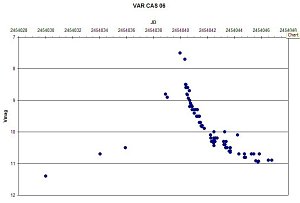
Another interesting possibility is if the lens itself is a fainter star with a solar system, the planets can also microlens the light, albeit for only short periods of a few hours. These spikes on the main event are a hot topic for microlensing studies and exoplanet hunters.
For a "standard" microlensing event, take a look at this one: 4 magnitudes over a few days time.
Interested in the theory behind microlensing? Take a look at this FSU course.
To see the star at or near maximum, see: http://www.irishastronomy.org/
or here, although the star is not marked and is not obvious (magnitude 7.5 stars are a dime a dozen in the Milky Way).
Astronomers will be watching this star closely to see how the light dims in the next few weeks--to make sure it really was a microlensing event!
Wednesday, November 08, 2006
Mercury Transit
Monday, October 30, 2006
International Space Station pass -- seen through a telescope
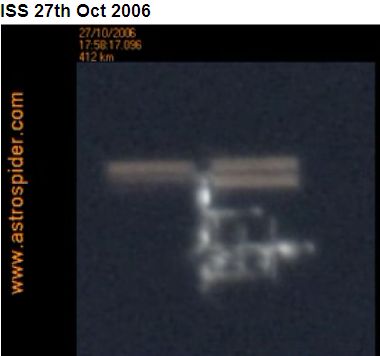
The ISS is the largest artifical satellite orbiting Earth -- with 240ft long solar panels and a 150ft long body, its mass is over 227 tons. Being this big, and orbiting at only a 350km altitude, it can be discerned as a non-pointlike object with a normal sized telescope. If your telescope can keep up, that is. The ISS crosses the sky in about five minutes. It's usually much easier just to enjoy watching it look like a bright star crossing the sky (predictions here: Heavens-Above.com)
Mike Tyrrell followed the ISS in his 10" Meade telescope and made a fantastic video, a three minute pass sped up 8x.
The old Mir space station before its demise appeared as a blazing "T" shape in the Ryerson telescope.
Thursday, October 26, 2006
Janus above Saturn
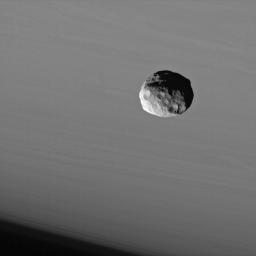
Janus orbits above Saturn, taken from the Cassini spacecraft.
http://saturn.jpl.nasa.gov/multimedia/images/image-details.cfm?imageID=2337
Thursday, October 19, 2006
New title background
I derived the background from an image taken through a homebuilt spectroscope at Ryerson Observatory.
Here's a couple of crops of the same image:

And another one: Blue solar spectrum
I have a link to a PDF of an analysis of the absorption lines here:
http://www.kwasan.kyoto-u.ac.jp/~kamio/archive/spectrum/hb_1st.pdf
The sharp line just to the left of H-beta is Fe I, or unionized iron, for instance. I resized the image to match the scale on the PDF (at least how it appears on my computer); putting the two together gets you identifications of the lines in my image.

It isn't perfect--on the spectrum I did a motion blur in the vertical direction to smooth out noise, but I know everything is not perfectly vertical (I think there is some curvature of field in the spectroscope, and probably in the camera lens). In addition, the hydrogen beta line is definitely not symmetrical.
It's kinda neat that you can say there's iron, nickel, chromium, cobalt, titanium, and even maybe vanadium in the sun, yes?
I'm not sure I'm keeping this design, but for the moment it stays.
Monday, October 16, 2006
AAS Division of Planetary Science meeting news
Sunday, October 15, 2006
What they did to Jose Padilla
In an effort to gain Mr. Padilla’s "dependency and trust," he was tortured for nearly the entire three years and eight months of his unlawful detention. The torture took myriad forms, each designed to cause pain, anguish, depression and, ultimately, the loss of will to live. The base ingredient in Mr. Padilla’s torture was stark isolation for a substantial portion of his captivity. For nearly two years – from June 9, 2002 until March 2, 2004, when the Department of Defense permitted Mr. Padilla to have contact with his lawyers – Mr. Padilla was in complete isolation. Even after he was permitted contact with counsel, his conditions of confinement remained essentially the same. He was kept in a unit comprising sixteen individual cells, eight on the upper level and eight on the lower level, where Mr. Padilla’s cell was located. No other cells in the unit were occupied. His cell was electronically monitored twenty-four hours a day, eliminating the need for a guard to patrol his unit. His only contact with another person was when a guard would deliver and retrieve trays of food and when the government desired to interrogate him.
His isolation, furthermore, was aggravated by the efforts of his captors to maintain complete sensory deprivation. His tiny cell – nine feet by seven feet – had no view to the outside world. The door to his cell had a window, however, it was covered by a magnetic sticker, depriving Mr. Padilla of even a view into the hallway and adjacent common areas of his unit. He was not given a clock or a watch and for most of the time of his captivity, he was unaware whether it was day or night, or what time of year or day it was.
In addition to his extreme isolation, Mr. Padilla was also viciously deprived of sleep. This sleep deprivation was achieved in a variety of ways. For a substantial period of his captivity, Mr. Padilla’s cell contained only a steel bunk with no mattress. The pain and discomfort of sleeping on a cold, steel bunk made it impossible for him to sleep. Mr. Padilla was not given a mattress until the tail end of his captivity. Mr. Padilla’s captors did not solely rely on the inhumane conditions of his living arrangements to deprive him of regular sleep. A number of ruses were employed to keep Mr. Padilla from getting necessary sleep and rest. One of the tactics his captors employed was the creation of loud noises near and around his cell to interrupt any rest Mr. Padilla could manage on his steel bunk. As Mr. Padilla was attempting to sleep, the cell doors adjacent to his cell would be electronically opened, resulting in a loud clank, only to be immediately slammed shut. Other times, his captors would bang the walls and cell bars creating loud startling noises. These disruptions would occur throughout the night and cease only in the morning, when Mr. Padilla’s interrogations would begin.
Efforts to manipulate Mr. Padilla and break his will also took the form of the denial of the few benefits he possessed in his cell. For a long time Mr. Padilla had no reading materials, access to any media, radio or television, and the only thing he possessed in his room was a mirror. The mirror was abruptly taken away, leaving Mr. Padilla with even less sensory stimulus. Also, at different points in his confinement Mr. Padilla would be given some comforts, like a pillow or a sheet, only to have them taken away arbitrarily. He was never given any regular recreation time. Often, when he was brought outside for some exercise, it was done at night, depriving Mr. Padilla of sunlight for many months at a time. The disorientation Mr. Padilla experienced due to not seeing the sun and having no view on the outside world was exacerbated by his captors’ practice of turning on extremely bright lights in his cell or imposing complete darkness for durations of twenty-four hours, or more.
Mr. Padilla’s dehumanization at the hands of his captors also took more sinister forms. Mr. Padilla was often put in stress positions for hours at a time. He would be shackled and manacled, with a belly chain, for hours in his cell. Noxious fumes would be introduced to his room causing his eyes and nose to run. The temperature of his cell would be manipulated, making his cell extremely cold for long stretches of time. Mr. Padilla was denied even the smallest, and most personal shreds of human dignity by being deprived of showering for weeks at a time, yet having to endure forced grooming at the whim of his captors.
A substantial quantum of torture endured by Mr. Padilla came at the hands of his interrogators. In an effort to disorient Mr. Padilla, his captors would deceive him about his location and who his interrogators actually were. Mr. Padilla was threatened with being forcibly removed from the United States to another country, including U.S. Naval Base at Guantanamo Bay, Cuba, where he was threatened his fate would be even worse than in the Naval Brig. He was threatened with being cut with a knife and having alcohol poured on the wounds. He was also threatened with imminent execution. He was hooded and forced to stand in stress positions for long durations of time. He was forced to endure exceedingly long interrogation sessions, without adequate sleep, wherein he would be confronted with false information, scenarios, and documents to further disorient him. Often he had to endure multiple interrogators who would scream, shake, and otherwise assault Mr. Padilla. Additionally, Mr. Padilla was given drugs against his will, believed to be some form of lysergic acid diethylamide (LSD) or phencyclidine (PCP), to act as a sort of truth serum during his interrogations.
Throughout most of the time Mr. Padilla was held captive in the Naval Brig he had no contact with the outside world. In March 2004, one year and eight months after arriving in the Naval Brig, Mr. Padilla was permitted his first contact with his attorneys. Even thereafter, although Mr. Padilla had access to counsel, and thereby some contact with the outside world, those visits were extremely limited and restricted. Significantly though, it was not until Mr. Padilla was permitted to visit with counsel that one of his attorneys, Andrew Patel, was able to provide Mr. Padilla with a copy of the Qur’an. Up until that time, for a period of almost two years, Mr. Padilla was the right to exercise his religious beliefs.
The deprivations, physical abuse, and other forms of inhumane treatment visited upon Mr. Padilla caused serious medical problems that were not adequately addressed. Apart from the psychological damage done to Mr. Padilla, there were numerous health problems brought on by the conditions of his captivity. Mr. Padilla frequently experienced cardiothoracic difficulties while sleeping, or attempting to fall asleep, including a heavy pressure on his chest and an inability to breath or move his body.
In one incident Mr. Padilla felt a burning sensation pulsing through his chest. He requested medical care but was given no relief. Toward the end of his captivity, Mr. Padilla experienced swelling and pressure in his chest and arms. He was administered an electrocardiogram, and given medication. However, Mr. Padilla ceased taking the medicine when it caused him respiratory congestion. Although Mr. Padilla was given medication in this instance, he was often denied medication for pain relief. The strain brought on by being placed in stress positions caused Mr. Padilla great discomfort and agony. Many times he requested some form of pain relief but was denied by the guards.
The cause of some of the medical problems experienced by Mr. Padilla is obvious. Being cramped in a tiny cell with little or no opportunity for recreation and enduring stress positions and shackling for hours caused great pain and discomfort. It is unclear, though, whether Mr. Padilla’s cardiothoracic problems were a symptom of the stress he endured in captivity, or a side effect from one of the drugs involuntarily induced into Mr. Padilla’s system in the Naval Brig. In either event, the strategically applied measures suffered by Mr. Padilla at the hands of the government caused him both physical and psychological pain and agony.
It is worth noting that throughout his captivity, none of the restrictive and inhumane conditions visited upon Mr. Padilla were brought on by his behavior or by any actions on his part. There were no incidents of Mr. Padilla violating any regulation of the Naval Brig or taking any aggressive action towards any of his captors. Mr. Padilla has always been peaceful and compliant with his captors. He was, and remains to the time of this filing, docile and resigned – a model detainee.
Mr. Padilla also wants to make clear that the deprivation described above did abate somewhat once counsel began negotiating with the officials of the Naval Brig for the improvements of his conditions. Toward the end of Mr. Padilla’s captivity in the Naval Brig he was provided reading materials and some other more humane treatment. However, despite some improvement in Mr. Padilla’s living conditions, the interrogations and torture continued even after the visits with counsel commenced.
In sum, many of the conditions Mr. Padilla experienced were inhumane and caused him great physical and psychological pain and anguish. Other deprivations experienced by Mr. Padilla, taken in isolation, are merely cruel and some, merely petty. However, it is important to recognize that all of the deprivations and assaults recounted above were employed in concert in a calculated manner to cause him maximum anguish. It is also extremely important to note that the torturous acts visited upon Mr. Padilla were done over the course almost the entire three years and seven months of his captivity in the Naval Brig. For most of one thousand three hundred and seven days, Mr. Padilla was tortured by the United States government without cause or justification. Mr. Padilla’s treatment at the hands of the United States government is shocking to even the most hardened conscience, and such outrageous conduct on the part of the government divests it of jurisdiction, under the Due Process clause of the Fifth Amendment, to prosecute Mr. Padilla in the instant matter.
Thursday, October 12, 2006
Robins singing earlier due to light pollution, part 2
Link to Apparent Effects of Light Pollution on Singing Behavior of American Robins (PDF)
HTML link
Friday, October 06, 2006
Opportunity spotted by HiRISE camera from Martian orbit
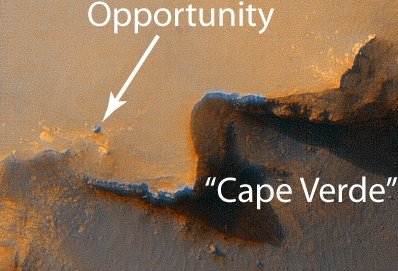
Bad Astronomy: Best Mars Picture Evah
Fantastic resolution, as previously noted.
NASA release
JPL release
P.S. They've also released a color image from Victoria Crater. The cliff I created a color image for before is now called "Cabo Frio".
Direct Link to HiRISE press release.
Wednesday, October 04, 2006
Synthesized color image of Victoria Crater cliff on Mars from Opportunity

I took three images from the raw frames available on JPL's Mars Rover web site and created a color image. They are not the fully correct colors: I used the "near-IR" (750nm) filter for red, green for green, and the UV (or short-pass 430nm) filter for blue. Opportunity Color filter IDs are from Mars Rover Pancam Filter Specs. I sharpened the image and slightly reduced the cyan content. Colors are, as you should always suspect, suspect. Click on the image above to get the full 1024x1024 image.
Saturday, September 30, 2006
Hi-res images from HiRISE: a transform fault on Mars
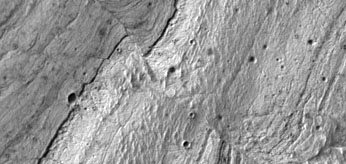
HiRISE (The High Resolution Imaging Science Experiment) is on the Mars Reconnaissance Orbiter (MRO) and offers 1 meter / pixel resolution. They've just taken a few images from yesterday and released them. (The official blurb says the resolution is 25cm/pixel on this image).
Big images--this one is a 1.3MB JPEG, it shows a region in Valles Marineris called Ius Chasma.
Take a look in the middle of the big image, or look at my crop above--that sure looks like a transform fault!
HiRISE via http://wohba.com/2006/09/hirise-hi-res.html.
UPDATE: They've spotted it and added commentary. They are intrepreting it as a thrust fault tilted on its side. Great resolution on their images.
Friday, September 29, 2006
Opportunity reaches Victoria Crater on Mars

The Mars Rover Opportunity has reached Victoria Crater on Mars: a half-mile in diameter.
They've taken a panorama from the rim (2.7MB).
Take a look at this full-res sharp image of a cliff to right of the rover: http://marsrovers.jpl.nasa.gov/gallery/all/1/p/952/1P212696205EFF76EKP2388R1M1.JPG
The rock has a smooth almost sculpted quality to it.
No color images yet--they've concentrated on stereo images.
Sunday, September 24, 2006
Content-free update
Friday, September 22, 2006
NYTimes review of Posner book
The New York Times' MICHIKO KAKUTANI slams Posner's new book:
"...a depressing relativism in which there are no higher ideals and no absolute rights worth protecting."
"By the end of this chilling book, the reader realizes that Judge Posner is willing to use virtually any argument — logical or not — to redefine constitutionally guaranteed rights like freedom of speech during wartime."
"...this book suggests that Judge Posner does regard the Constitution as an old piece of parchment — a piece of parchment with certain rules, but rules that “are made to be broken” by a president during an emergency, no matter how long that emergency may last."
Not a Suicide Pact: The Constitution in a Time of National Emergency.
By Richard A. Posner.
UPDATE: There is some back and forth debate on the University of Chicago Law School Faculty blog about it here and here. Posner actually states:
Civil liberties are valuable, but their values should be assessed in a practical, hard-headed way, rather than treated with quasi-religious veneration. Maybe David Hume went too far (though I don’t think so) when he said that “The safety of the people is the supreme law. All other particular laws are subordinate to it, and dependent on it.” But I am not prepared to die at the hands of terrorists in order to defend the Miranda rule, or Brady, or Burton, or Mapp, or Doyle, or the other arabesques that the Supreme Court in the Earl Warren era inscribed on the helpless text of the Constitution.
Geez... he seems to have forgotten his oath to defend the Constitution, and "that all men are created equal, that they are endowed by their Creator with certain unalienable Rights, that among these are Life, Liberty and the pursuit of Happiness."
At least Geoffrey Stone is able to contain him somewhat.
Tuesday, September 19, 2006
When the Cato Institute and I agree
"Doublespeak and the War on Terrorism by Timothy Lynch" (PDF).
Monday, September 18, 2006
Shuttle and ISS in front of the Sun
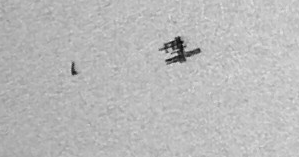
Wow. Thierry Legault in France caught the Space Shuttle undocking from the ISS while transiting the Sun from his location. Keep in mind the ISS transits the sun in about a fifth of a second. Click on the image for the full frame.
As seen on Spaceweather.com"
Wednesday, September 13, 2006
2003 UB313 named!
From the Minor Planet Mailing list (via the IAU Circulars):
(134340) PLUTO, (136199) ERIS, AND (136199) ERIS I (DYSNOMIA)
Following the Aug. 24 resolution by the IAU to the effect that
the solar system contains eight "planets" (Mercury-Neptune), with
(1) Ceres, Pluto (cf. IAUC 255), and 2003 UB_313 (cf. IAUC 8577) to
be considered representative "dwarf planets", the Minor Planet
Center included Pluto and 2003 UB_313 (along with two other new
potential dwarf-planet candidates) in the standard catalogue of
numbered objects with well-determined orbits as (134340) and
(136199), respectively (see MPC 57525). Following near-unanimous
acceptance by both the Committee on Small-Body Nomenclature and the
Working Group on Planetary-System Nomenclature (in consultation
with the discovery team), the IAU Executive Committee has now
approved the names Eris for (136199) and Dysnomia for its satellite
(136199) Eris I [formerly S/2005 (2003 UB_313) 1; cf. IAUC 8610].
special PDF circular
Eris is the goddess of strike, discord, and rivalry, and Dysnomia is the goddess of lawlessness.
My last post about the MPC designations for Pluto & the other large KBOs
2003 UB 313, Pluto, and other related Kuiper Belt posts:
An animation of Pluto
Direct measurements of 2003 UB 313
More science on 2003 UB 313
The The definition of a planet: IAU conference and the issue of 2003 UB313
Pluto's new moons named: Nix and Hydra
New Horizons--aka the Pluto and Kuiper Belt mission
Ortiz response
2003 EL61: bulgy or salt and pepper?
Huge new Kuiper Belt Object / Transneptunian Object?
Sunday, September 10, 2006
Longwave beacons part 2
So, here are two beacons recorded via Hamscope. Time is vertical, going up, and frequency is horizontal (but unimportant):
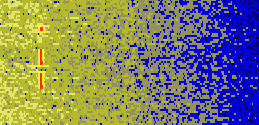
ME-Medinah
OH-O'Hare
Thursday, September 07, 2006
Pluto and other KBOs (2003 UB313) get designations
(134340) Pluto
Additional identifications = Object Lowell Observatory = X
(136199) 2003 UB313
(136472) 2005 FY9
(136108) 2003 EL61
etc...
Minor Planet Designations
Andrew Lowe over at the Minor Planet Mailing List figured this out.
A tradition in the minor planets was to name the "special" numbers after something special: (8000) Isaac Newton, (20000) Varuna, (50000) Quaoar, etc. A great opportunity was lost when (100000) wasn't designated as Pluto.
Wednesday, September 06, 2006
Dust cloud from SMART-1 impact
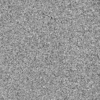
Phil Plait points out C. Veillet at CFHT also picked up the expanding dust cloud from the SMART-1 impact by subtracting the existing image of the moon against post-impact images. Animation here.
Even better: a wide-field video of the crash.
Full details at http://www.cfht.hawaii.edu/News/Smart1/, from Canada-France-Hawaii Telescope / 2006.
Tuesday, September 05, 2006
Longwave radio beacons
This band is defined (PDF) as 300kHz down to 30kHz. From 525kHz (the bottom of the AM dial) to 300kHz is technically still medium-wave but feels miles away from the AM band. It is mostly used for radionavigation for aircraft and ships, plus there are small allocations for the WWVB time broadcast at 60kHz and the 500kHz maritime distress frequency.
It's been neat to scan this new piece of spectrum I've never listened to before. Once you get past all the horrific noise (from switching power supplies, powerlines, etc. you start to hear the morse code IDs of all the radionavigation beacons around the airports near you.
In Chicago, I've heard five stations and if you record the morse code IDs, you can find where they broadcast from.
frequency(kHz) / ID / bearing(degree) / power(watts) / location / airport
- 332 HK 80/260 25 Hickory Hills, IL MDW
- 350 ME 315/135 400 Medinah , IL ORD
- 356 IUL 315/135 25 La Porte, IN PPO
- 362 RZL 350/170 -- Rensselaer, IN RZL
- 367 OH 315/135 -- Arlington Heights, IL ORD
There is also a slow "T" morse code beacon at 317kHz-318kHz, repeating precisely every 23 seconds, that I've been unable to identify. It's faint enough that I can't find the direction because I only hear if I null out all noise, which has it NE/SW.
DXinfocentre has a NDB list that is handy for quick ID. You can get a lot (by a lot I mean a lot) of more info if you enter the morse ID into Airnav's system here
Take the coordinates from either site and paste them into Google Maps to quickly locate the beacon.
Most of the beacons line up with runway approaches at the various airports, although RZL's is just at the airport itself. In the case of "ME", you can see it's an active approach here. and here. and here.
What's neat about the bearings (which came from the Degen's internal loopstick AM antenna), is that you can figure out where you are in relation to each beacon. Two beacons, roughly 90 degrees apart at your location, can give you a good fix about where you are. Any radio with an internal antenna like the Degen can be used like this for direction finding: the antenna is most sensitive to the front and back of the radio (as the loop inside is usually mounted horizontally lengthwise in the radio).
The Degen 1103 suffers from overloading from strong AM radio stations, and it exhibits a lot of fake radio stations (called images) in the longwave band that are just nearby transmitters.
There are other beacons and radio stations out there in this band (Europe has a whole set of actual commercial radio stations down there), but I haven't heard them with all the noise in the neighborhood. It looks like I'll need to make a better antenna to catch anything else than these stations.
Saturday, September 02, 2006
SMART-1 moon crash
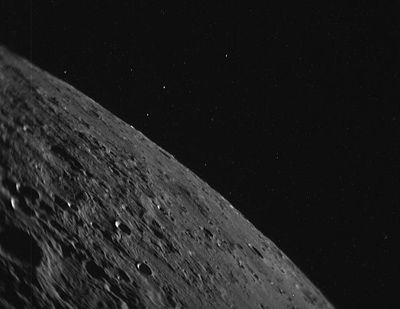
Alas, the Europeans modified the orbit of SMART-1 to avoid smashing into a crater one orbit early at 00:39 UT tonight, so that it will most likely impact at 05:43, the next perilune. Unfortunately this moves the impact from 7:39PM CDT to 12:43AM CDT, or quite literally, the moon having set all with but a sliver left above the horizon here in Chicago.
UPDATE: An image of the crash from the Canada-France-Hawaii-Telescope (CFHT)
Friday, September 01, 2006
Ariel passing in front of Uranus
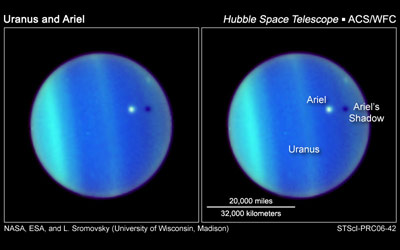
This is great: the axis of Uranus' rotation axis is nearly perpindicular to our line of sight, for the first time in 42 years, and now moons of Uranus are transiting across the face of Uranus.
Uranus and Ariel from HST
Wednesday, August 30, 2006
Fog inhibits diurnal convection

Today's satellite image and animation for the tri-state area of Wisconsin, Iowa, and Minnesota shows a prime example of the power of sun-heated land. There is a pool of colder air aloft in the western Great Lakes that by itself isn't enough to cause instability. But add heating from the Sun at ground level and the gradient is enough to produce convection and clouds.
A fog bank was present overnight and into the middle of the day over the tristate region, as seen in this morning image. The fog was burned off by the sun but it took until the early afternoon to do so and kept the ground cooler. Ergo, no cumulus where the fog was earlier.
This animation is during the afternoon as the bank slowly dissipated, leaving a kidney-shaped hole in the cumulus field.
Friday, August 25, 2006
An animation of Pluto
Zelia parallax
http://www.caelumobservatory.com/gallery/zelia.shtml
The asteroid (er, I'm sorry, Small Solar System Body), was about 100 million kilometers from Earth when the images were taken.
Images taken by Adam Block, Daniel Versatche, and Bill Patterson.
Thursday, August 24, 2006
IAU and the planet definition
Wednesday, August 23, 2006
Amateur nuke detectors
With sodium iodide (and other inorganic crystals), a gamma-ray will interact with one of the electrons bound deep inside one of the atoms and liberate it, producing an electron with some energy, plus an X-ray with the excess energy of the reaction. The photoelectron can then interact with normally bound electrons in the crystal, liberating them into what is called the "conduction band" and allowing them to migrate through the crystal. They and the positively-charged hole can move around until they meet with an impurity in the crystal. This can, if the impurity is chosen correctly, cause a fluorescence of visible photons. In sodium iodide, Thallium is added as the impurity at about 1 part per thousand. While a great scintillator, NaI(Tl) is expensive and absorbs water.
Certain organic molecules will also directly fluoresce when given excess energy from these passing photoelectrons or other energetic charged particles. Certain plastics can also be used: in fact, polystyrene, a very cheap material, can be used.
Once visible photons are produced, they are measured via a photomultiplier tube or other light-measuring device.
The amount of visible photons developed in these materials is directly proportional to the energy of the original gamma-ray. This is great, as you can detect precisely what radioactive decay was responsible for the gamma-ray, and therefore what radioactive element you may be looking at.
You can see a terrestrial gamma-ray map of the United States here. They separate out three common radioactive that are present in nearly all rocks and soils via this proportional energy measurement. A more detailed description of airborne radioactivity mapping is here.
Friday, August 18, 2006
Geologist causes a ruckus
Bloggers might write reams and reams about Israel and Lebanon, but what might really cause an international dispute is Canada and Denmark!
Green Gabbro has the best link title for this story.
Cell phones, terrorists, and Tuscola County, Michigan: update
"There's real suspicion on my part, when you get these other charges, that you get this face-saving, 'Well, we've locked them up and we've got to charge them with something."'
--David A. Moran, associate dean at Wayne State University Law School
When they realize how they have no case, they will do their best to have the men plea bargain something, however light, to prove the case wasn't the amazing reach it is.
Boing-boing missed the part where the terrorism charges were dropped and replaced with fraud charges.
Doctrine of first sale indicates there is no fraud here. Unfortunately some people don't get it.
For instance, using the term "black-market" in a story implies that somehow it's illegal to sell goods you've bought legally. It isn't. Nor is it illegal to remove a possibly illegal restriction on use of the phone (The carriers block your ability to use your phone with other carriers' SIM cards, yet you can get the carriers or a third-party store to unblock the phone... usually for a fee). How is doing this by yourself then illegal?
Wednesday, August 16, 2006
The definition of a planet: IAU conference and the issue of 2003 UB313
Pluto was long too small to really match into the classical planets without letting other bodies like 2003 UB313 in, and now a committee has suggested simply the "spherical body not orbiting another object" suggestion, which includes some other minor planets in it including Pluto. You can't have Pluto in a real definition as a planet and not Ceres and some of the big Kuiper Belt objects without putting an arbitrarily size limit on the definition and this drove astronomers to impasse.
The "Spherical bodies" idea was agreed by some as a radical definition that would bestow planet status on many objects; some argued it would dilute the idea of what a planet was. Keeping the old 9 planets and restricting 2003 UB313 was cruel and decidely the wrong thing to do. Putting a higher size limit to keep 2003 UB313 out would have been physically arbitrary and would have forced Pluto out of major planet status.
Brian Marsden, who just retired, long argued that Pluto really was nothing more than a large Kuiper Belt Object. It was unfortunate in my opinion that public sentiment drove the arguments about was a planet was more than science. He makes the point that we will likely have a lot more planets in the near future when we prove the sphericity of the bigger minor planets and KBOs, and if the public doesn't like that, they chose to live with it by forcing Pluto into the issue.
UPDATE: Mike Brown's thoughts. And his NYTimes Op-ed.
Search this blog for "Pluto"
Search this blog for "2003 UB313"
UPDATE: Looks like they've come to their senses.
Monday, August 14, 2006
Tuscola County stupidity: cell phones and Arabs in Michigan
Sunday, August 06, 2006
Number stations
Some other shortwave / radio posts:
Adventures in Shortwave: more Radio Havana Cuba
Adventures in Shortwave: Swahili on the radio
Adventures in shortwave: last night's Radio Habana Cuba
VLF radio: part 1
VLF Radio part 2: sferics
The Sun as a microwave source
The Sun as a 2.4 GHz source, redux
Friday, August 04, 2006
Weather is not climate
Those who can't remember the weather always say "It's never been so hot before". They tend to forget last year, or 1995, or 1988, etc. They tend to forget 1916, 1911, 1918. The entire Dust Bowl.
It's really important point: Weather is not climate. A heat wave is not the result of a change in climate. Weather is a day-to-day variation in temperature, humidity, etc. Climate is the long-term average of weather. On average, the climate of Chicago gives us 34 inches of water. On average. Look at the variation in yearly precipitation here. Even after averaging over 365 days, the average precipitation varies over +-10 inches of rain each year.
Look at the other graphs on the Chicago climate page.
The whole point is, you can't blame a single event, a single drought, a single year's weather on global warming. You can't. You can make statistical statements, but the natural variability of weather will mask any contribution by forced warming until you look at a long-term average (or some other greatly averaged variable).
Problematic web pages:
Treehugger: The Heatwave is On: Global Warming?
Bruce Sterling: Global Warming Knocks Out MySpace
Washington Post: More Frequent Heat Waves Linked to Global Warming
Someone took the research about reducing the well-known urban heat island effect and blame increasing nighttime temperatures on global warming, rather than accounting for the continued growth in urban areas.
Some comments here: Climate Science:Roger Pielke Sr. Research Group Weblog
Thursday, August 03, 2006
Adventures in Shortwave: more Radio Havana Cuba
Radio Habana Cuba end of editorial, religious response, music at end(04:14, 1.7MB mp3)
Essentially, the statement was, the Cuban people will continue to do all the good things they do now, and imperialist conspirators and their evil plans will not work.
Well wishes from world leaders and imprisoned Cubans in the U.S. (07:35, 3.5MB mp3)
Both were recorded on 9820kHz. There were thunderstorms in the vicinity. I used Audacity to record and removed some hum and nearby carrier whistles with some notch filters.
P.S. See also recordings from 2006-12-18 and 2006-07-13
Tuesday, August 01, 2006
NEXRAD radar and cars
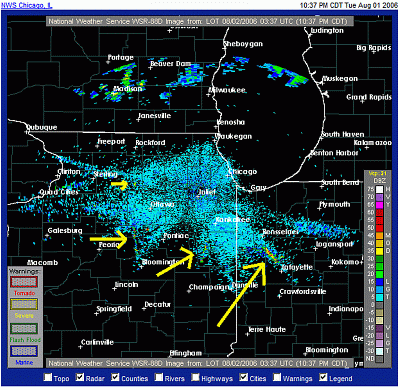
The NEXRAD radar near Chicago is bending back down to ground and lighting up cars on the highways south of town. I've labeled the image above with arrows to the returns. This image adds the highway overlay to the radar, showing the returns to be from I-65, I-57, and I-39. Earlier you could see I-55 on the return as well.
Looking at a balloon sounding from the nearest area (Lincoln, IL) shows an inversion at about 6000ft (1800m):
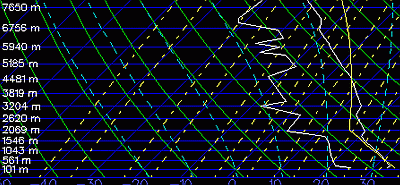 .
. This could be bouncing the beam back onto the ground on this hot steamy night.
The smallest arrow on the annotated radar image--what is that sitting out in eastern Lee County? It's static in the animation.
UPDATE: Google Earth link. What's at the corner of Beemerville Rd, Compton Rd, and 251?
2nd UPDATE: Silos on a topographic high?
Or a tall AM antenna? Probably the antenna.
3rd UPDATE: The antenna is 150m tall, listed in the FCC Antenna database, owned by ComEd.
Radiation readings
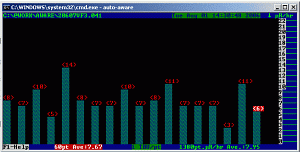
My long-term radiation average for my basement Geiger counter here at the Regenstein Library is 7.6uR/hr. Lately it's been elevated a touch. For the last 1372 minutes (or roughly a day), it's 7.95uR/hr. Over the last hour, it's at 8.38 (EDIT: in the space of writing this the last 60 count rate went down to 7.67. Love them statistics). All of this is so small that it doesn't matter but it's an interesting variation. Merely putting a simple aluminum can near the Geiger counter can drop the reading by 0.5uR/hr, so these changes aren't significant. I wonder if I've made some change in my office (or perhaps in the next office) that has changed the local background rate. The air is off too; perhaps that's allowing a small amount of radon to appear (which is normally non-existant in the library).
The popular Geiger Counter post. In which I graph the radiation on an airplane flight. And radon decay.
See the Genesis-1 spacecraft tonight in Chicago
The spacecraft rises in the northwest at 10:08PM, and passes the Big Dipper on its way to its maximum altitude of 62 degrees above the horizon in the southwest, above Arcturus, at 10:12PM. It enters the Earth's shadow at 10:13.
It should appear as a faint star, not much brighter than the faintest stars you can see (in Chicago), so get away from light sources and let you eyes adapt. It would be dimmer than most of the stars in the Big Dipper. Binoculars should help.
Don't confuse it with the Helios 1A rocket, which will be visible at nearly the same place and same time. You will be able to discern between them because the rocket body is moving to the north while Genesis-1 will be moving south-ish.
Pass details
Saturday, July 29, 2006
Has Orwell's '1984' Come 22 Years Later?
"This weekend my mother bought a grille lighter, something like this butane lighter. The self-scanner at Kroger's locked itself up and paged a clerk, who had to enter our drivers license numbers into her kiosk before we could continue. Last week my girlfriend bought four peaches. An alert came up stating that peaches were a restricted item and she had to identify herself before being able to purchase such a decidedly high quantity of the dangerous fruit. My video games spy on me, reporting the applications I run, the websites I visit, the accounts of the people I IM. My ISP is being strong-armed into a two-year archive of each action I take online under the guise of catching pedophiles, the companies I trust to free information are my enemies, the people looking out for me are being watched. As if that weren't enough, my own computer spies on me daily, my bank has been compromised, my phone is tapped--has been for years--and my phone company is A-OK with it. What's a guy that doesn't even consider himself paranoid to think of the current state of affairs?"
Tuesday, July 25, 2006
n-body orbits
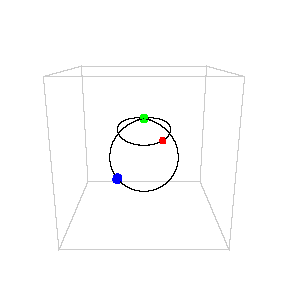
Sean Carroll at Cosmic Variance points out some bizarro but valid orbits of multi-body gravitational systems mentioned at "This Week's Finds in Mathematical Physics". Any system of more than two bodies is very difficult (or impossible?) to reduce to simple mathematical statements, although you can find occasional stable orbits of n-body systems. Cris Moore found some and Michael Nauenberg animated them.
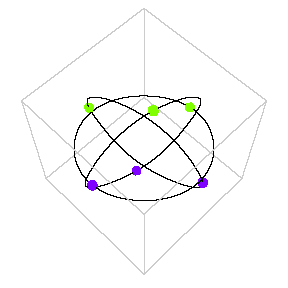
Thursday, July 20, 2006
Adventures in Shortwave: Swahili on the radio
I recorded a scan through the 31-meter international broadcast band, which is filled with stations on many nights. To me, this band is from 10MHz down to 9, but I think officially it's just 9500-9900kHz, although the frequencies around it have some broadcasters. I cut some short segments out of the big recording.
Deutsche Welle, broadcasting in Swahili (6:06, 3MB mp3). This recording is 6:25 in length, recorded on 7/11/2006, at 3:54UT, until end of transmission. Station ID is at 6:06.
The Program Schedule indicates I was listening to Jukwaa. The recording is a little shaky at the beginning, fighting with an adjacent American religious broadcaster playing music.
Everybody's favorite, the BBC World Service (4:32, 2.1MB mp3). I am guessing that this is a relay broadcast from Guyana, pointed towards the Caribbean. EDIT: In discussing this in the comments, I've found that it was broadcast from the UK towards South America.
Radio Habana Cuba, in French (1:19, 621kB mp3). As I wrote in the previous post, we receive Radio Havana Cuba pretty well here in Chicago. Station ID at 0:21.
The Voice of Russia (0:31, 251kB mp3).
Radio Netherlands 9845kHz (5:43, 2,680kB mp3). A story about new boat technologies. Radio Netherlands is a continued supporter of shortwave broadcasts to North America in the time of shrinking audiences.
Radio Croatia (I think), (1:03, 271kB mp3). This was recorded near WWV at 10MHz during a scan from WWV to 9MHz, so the frequency was near 9990kHz.
Kol Israel (1:41, 693kB mp3). To be honest, I have trouble distinguishing Hebrew and Arabic, but this definitely is Hebrew. I assume it's Kol Israel, but I know Family Radio out of Oakland California occasionally broadcasts in what sounds like Hebrew or Arabic.
Finally, a tougher recording. This is WWVH at 15MHz. (0:27, 427kB mp3). From 0:05-0:10 you can hear the female voice of WWV-Hawaii saying "At the tone, the time will be two hours, thirty-six minutes, Coordinated Universal Time". Normally we don't hear the Hawaiian time broadcast in Chicago; whereas I hear it all the time on the west side of the Rocky Mountains.
See the first post in this series:
Adventures in Shortwave: last night's Radio Habana Cuba
Friday, July 14, 2006
Adventures in shortwave: last night's Radio Habana Cuba
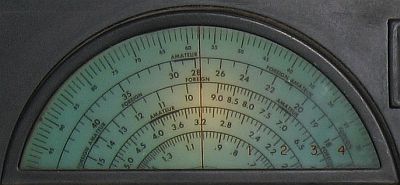
The Professor, a DJ at New York City's independent radio station WFMU, has a fantastic series in his regular blog about listening to old-time radio: that of long-distance AM radio and shortwave. He ends up posting audio clips of various shortwave stations you can hear. While it sounds boring, it's actually quite interesting. I offer up a 5-minute clip of Radio Havana Cuba from last night, with their regular news report. Cuba's propaganda station always highlights how the US is "actively conspiring" against Cuba or some random nation. Volume is a little low on the clip, so you might need to turn it up.
This clip was recorded from an ancient vacuum tube radio, a 1940's era Hallicrafters S-40A, in the Ryerson Astronomical Society's office. The signal-to-noise ratio wasn't anywhere near what is was a week ago, but it's ok. (I have a lot of recordings from that night to process).
P.S. Looking for the manuals to the S-40A? Bama.sbc.edu has 'em.
Thursday, July 13, 2006
Planet orbiting Pollux
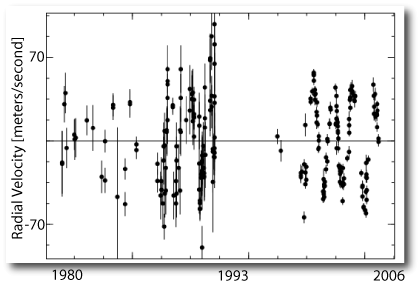
Systemic, everyone's favorite extrasolar planet blog, talks about the detection of a 2 or 3 Jovian-mass planet orbiting Pollux, aka Beta Geminorum. Preprints here and here
P.S. The graph above shows Pollux's velocity towards and away from Earth. You can see how it varies back and forth in a regular period, especially with the newer higher-quality data. Given the period and amount of wobbling, you can discover planets and their minimum masses.
Particulates in Chicago: source
Monday, July 10, 2006
Mayflies on Mississippi River show up on radar

NEXRAD radar is usually cleaned up a huge amount before it's released--things like ground clutter and bird returns are removed.
I grabbed a processed return from the archive at UCAR here.
It's not as dramatic as the processed return shown in the news story. I wonder where they got that particular image.
Massive insect swarms are nothing new for residents of the Midwest near lakes and rivers. On occasion, I've seen swarms of gnats take up residence in the lees of buildings along the lakefront in Chicago thick enough to resemble smoke.
Another common anomaly on NEXRAD radar is the Sun rising or setting--since it's a source of radio waves--strong enough to be detectable.
Via Boing-boing
Thursday, July 06, 2006
Particulates
UPDATE: Probably this fire.
Tuesday, July 04, 2006
Happy Fourth of July!
Sunday, July 02, 2006
NSA and domestic phone spying before 9/11
Bloomberg has the story, and I'm guessing Radio Havana picked it up from there.
That said, I wouldn't trust Radio Havana Propaganda for ANY news, which is why I went looking for proof of the existence of the story as soon as it crossed the airwaves.
Friday, June 30, 2006
The Moon on June 29th

Michael Milligan blogged his viewing of the Moon through the University of Minnesota's 10-inch refractor last evening. A great coincidence (aka clear skies for us both) had me at Ryerson viewing the Moon that evening too. It was a useful starting point to Saturn, Mars, and even the elusive Mercury. I also looked at Jupiter to add to the planet list.
I too photographed it, although I waited until the sun had set, taking the first image at 8:45PM with the intention of getting some of the twilight blue in the image.
This second image is a point-of-view image through the viewfinder.
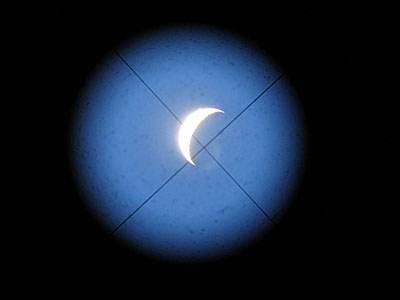
Earlier I also branded a piece of wood with an "R" for Ryerson using the sun's setting rays.
Thursday, June 29, 2006
The Antennae galaxy from Chicago
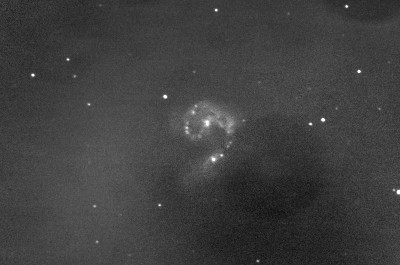
I am guessing that the Astronomy Picture of the Day for tomorrow, with the title "cosmic antennae", is likely to be about the Antennae Galaxy, an interacting pair 63 million light-years away in Corvus the Crow, visible now as a compact quadrilateral to the far lower-right of Jupiter blazing in the south after sunset. So, I'm posting a poor image of them now, because otherwise the APOD gets me every time in posting something I should have posted earlier.
I imaged the Antennae (also known as NGC 4038/4039) on April 26th from Ryerson Observatory. The total exposure time was about 85 minutes. My light-polluted skies overwhelmed the faint antennae structure of stars thrown out of the galaxies during the collision. I can see the individual superclusters of bright blue supergiants formed during intense starbirths from the compression of gas clouds during the collison. The two brightest knots in the galaxy (oriented roughly vertical in my image) are actually the cores of the original pre-collision galaxies.
Any variations in the dark gray background are dust donuts from the telescope, and leftovers of a smoothing feature I used to help get rid of the vignetting. My flats were not good enough to use for this processing.
Friday, June 23, 2006
A color illusion
Click here for the illusion:
http://www.lib.uchicago.edu/~dean/blog/illusion.html
The idea is from John Sadowski
I need to find a better horizontal image for this illusion.
Wednesday, June 21, 2006
Pluto's new moons named: Nix and Hydra
Forbes article
Blog post about discovery
Cute:
"The 'P' and the 'L' in Pluto are in honor of the Percival Lowell, who instigated the search that resulted in the discovery of Pluto," Stern told Space.com. "The 'N' and the 'H' are exactly parallel to honor New Horizons which instigated the search that led us to [the new satellites]."
Info from the Southwest Research Institute
Monday, June 19, 2006
A triple junction in the Sky

I called the entry "A Triple Junction in the Sky" because of three distance scales that converge at this place in the sky. Leo I, being a (barely) extragalactic source, is that of all things outside of our own galaxy. It's not the farthest thing in the image; there are many angularly small galaxies that are quite a distance aways. The second scale is stellar: Regulus shines at 75 light-years away. One of the four Royal Stars of Persia, it quarters the sky with Aldebaran, Antares, and Fomalhaut.
The third scale, not visible in the image, is the the planetary scale. Regulus lies nearly on the ecliptic, the plane of the solar system, and the moon frequently occults Regulus. In fact other planetary objects can occult Regulus: the asteroid Rhodope covered it for a few seconds in Europe in 2005. Astronomers can use these occultations to measure the sizes of asteroids.
Be sure to see the large-sized image.
Image copyright: © 2005 Russell Croman, www.rc-astro.com
Wednesday, June 07, 2006
Yerkes Observatory sold

Sure enough, the University has sold Yerkes Observatory to Mirbeau Spa for $8 million. They get most of the land surrounding the observatory for their 72 house development and spa and donate the observatory building and nearby grounds to the city of Williams Bay, which has to agree to this. A non-profit will run the observatory, although the University is paying for the operation for 5 years and the claim is that special taxes of an unknown sort will fund the observatory's mission after that.
Chicago Tribune story archived via U of C News Office.
Official University Press Release
Tuesday, June 06, 2006
Yerkes Observatory News
Friday, June 02, 2006
The Permian-Triassic Extinction: a source?
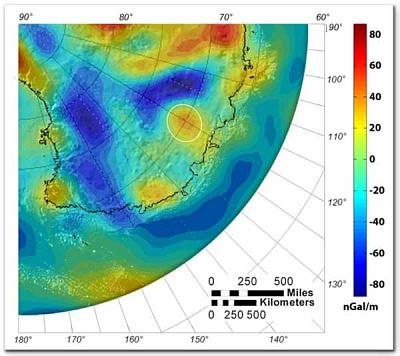
Ralph von Frese argues that a structure in the crust under Antarctica is a 500km wide impact crater and speculates that is was the source of the Permian-Triassic Extinction event which killed off 90% of all marine species.
Confirmation of this theory would require at least two things: the presence of shocked minerals near the impact crater, and dating of the crater to near the boundary (245 million years ago). It has been assumed by many that if there was an extraterrestial impact that caused the extinction it had hit in an ocean basin, and the evidence on the sea floor had long been subducted (the maximum age of oceanic crust in the Pacific is Jurassic in age).
Some images are here.
EDIT: There is some counter-arguments at Nature. Link via The Esoteric Science Resource Center.
Monday, May 29, 2006
Noctilucent clouds: A volcanic ash cloud from Mt. Pinatubo
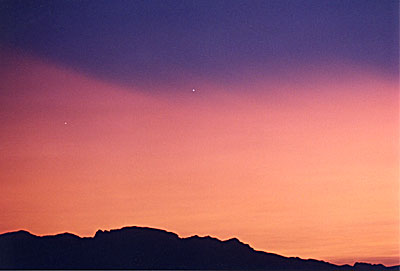
I have never seen a noctilucent cloud.
I've been far enough north before, roughly the arctic circle, but I
was up there in September and the clouds are entirely summer events, lit up by sunlight streaming over the pole.
I believe though, that I've seen what they would look like. In late
June of 1991 I was living in Las Vegas with my parents (that's what being in high school will do for you) and was in complete harmony with celestial cycles. Sunrise, sunset, moon phases, etc. There is room for another post in that, but the point I am trying to make was that I was very sensitive to the timing of the sunset and the fading of the daylight.
Mount Pinatubo in the Phillipines blew itself apart in one of the largest eruptions of the 20th century on June 15th. The explosion sent cubic kilometers of material high into the atmosphere, breaking into the stratosphere. Once material is in the stratosphere, the only way of removing it is by gravity or ultraviolet light destruction. Small particles fall really slowly, yah? I didn't think an explosion located literally on the other side of the globe would be so evident.
The sun had just set and I was in my bedroom reading with the fading twilight that was still coming through the windows. After about fifteen minutes, I noticed that instead of getting darker, it had suddenly brightened outside. I went out and was shocked to see a broad glowing cirrus cloud covering the western horizon up to about thirty degrees above the Spring Mountains. The cloud was glowing eerie white-yellow against the deepening blue. I was shocked enough to get my father and showed him
the cloud. It was like a spiderweb of cirrus. The color deepened into fluorescent pink and then faded away nearly an hour after sunset. For a few weeks details in the cloud could still be seen--although it spread and faded away. The nights were not as clear for a year afterward, as the ash slowly fell out of the stratosphere.
The Cocteau Twins "Heaven or Las Vegas" album art reminds me of this period and of the glowing cloud in the west that night.
P.S. This entry was originally written two years ago. I finally found an image I took of it and Venus.
Tuesday, May 23, 2006
Geiger counter for Regenstein back up
89. Find the most radioactive place you can get on campus without breaking any rules, laws, or safety regulations. Record the radioactivity level in μrad/h. [5 points. -100 points if we have to call radiation safety].
Saturday, May 20, 2006
Monday, May 08, 2006
Comet Schwassmann Wachmann 3 passes the Ring Nebula

A fragmenting comet passed the Ring Nebula yesterday:
Animation from Horace Smith
Color image from Stefan Seip / Steffen Brückner.
Spaceweather has many images of the conjunction.
EDIT: This one by Johannes Schedler is great.
SECOND UPDATE: Even Better.

